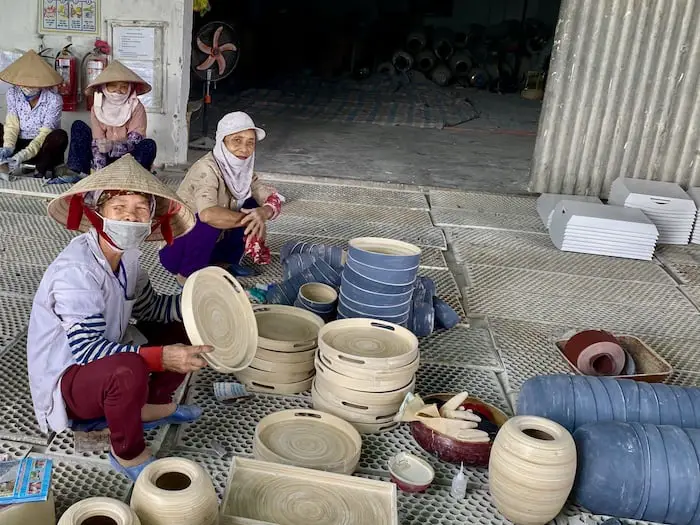Spun Bamboo is an 800-year-old Vietnamese handicraft technique. Like so many home decor manufacturing techniques, spun bamboo has an interesting history and shows the Vietnamese people’s ingenuity.
Spun bamboo was invented in Vietnam over 800 years ago to give a cheaper alternative to the home decor and home utensil materials that were then being used. Spun bamboo is called spun bamboo as it is spun out pieces of bamboo, and then the bamboo pieces are glued together into a form. This spun bamboo production helps women in these villages earn an extra income. Spun bamboo is a great natural product and can be used in a variety of home decor and kitchen products.
Table of Contents
- Spun Bamboo – An 800-year-old Vietnamese Invention
- Helping Women to Earn Extra Income
- Preparing the Bamboo Material for Spun Bamboo Production
- Using Spun Bamboo in Home Decor Production
- Spun Bamboo – A Renewable and Eco Product
- Frequently Asked Questions
- Related Questions
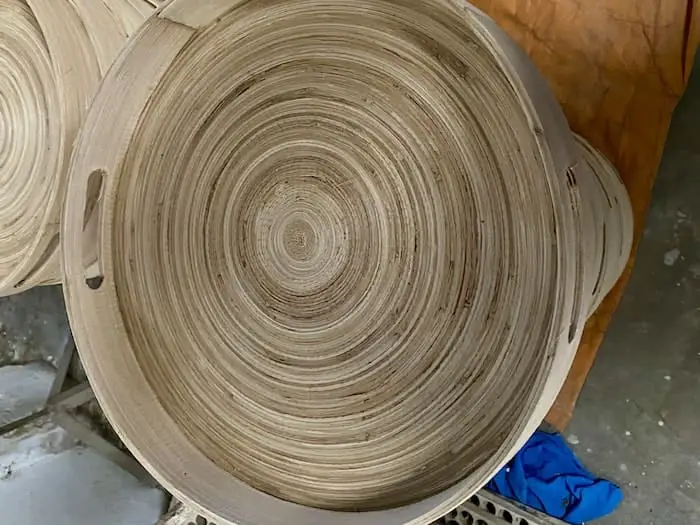
Spun Bamboo – An 800-year-old Vietnamese Invention
Vietnam has been producing spun bamboo for over 800 years in handicraft villages for about 2 hours outside Hanoi. Like many handicraft villages in Vietnam, the villages’ families have consistently produced spun bamboo for over 800 years.
Bamboo is a material that is abundant and relatively cheap in Vietnam. About 800 years ago, the Vietnamese started looking for a less costly alternative to produce household and kitchen utensils in ceramic, wood, or metal.
The Vietnamese discovered a way to dry, soak, cut, and split the bamboo to be bent into mainly rounded shapes. This is why it is called spun bamboo in that the strips of bamboo are literally spun and then glued into these shapes.
As spun bamboo was a cheaper alternative to ceramics, wood, and metal, the Vietnamese also discovered that they could lacquer the spun bamboo to add beauty. Spun bamboo is an extremely clever Vietnamese invention that was borne out of economic necessity to give the poorer Vietnamese people an alternative to ceramic, wood, and metal kitchenware and other household utensils.
Watch Our Video On How Spun Bamboo is Made
(Click on our Video Below)
Helping Women to Earn Extra Income
Like many kinds of Vietnam production, a major part of the spun bamboo production is done in village households in the spun bamboo handicraft villages by women workers.
Here are some of the reasons why this production is partly produced in the spun bamboo handicraft villages:
- Highly Skilled Workers – As the households in the villages have been producing this handicraft for hundreds of years, the skills are passed down from parents to their children or generation to generation. This means the workers in these villages are highly skilled.
- Readily available materials. – In the area where they are producing spun bamboo, they also have the materials readily available. The spun bamboo material is prepared and stored out in the villages.
- They have the equipment – Though most of the production is done by hand, there is a little bit of machinery there is required. The households or villages have this equipment that is needed for the manufacturing of spun bamboo.
- Helps Give The Village Women Extra Income – Most of the spinning spun bamboo products are women. Their husbands may run a small farm, and the wives stay at home to spin the bamboo to help give their families much needed extra income. This kind of work allows these farm women to be able to stay at home and look after their children and their farms while still being able to earn some much needed extra income.
- Economies of scale – As these households are so skilled at spinning the spun bamboo, they have the advantage of economies of scale. They can usually produce it cheaper and more efficiently than a larger factory could.
Preparing the Bamboo Material for Spun Bamboo Production
The bamboo used for spun bamboo is usually cut at the knot in about 70 to 80 cm. This allows it to be easily transported to the handicraft villages.
Once it comes into the village, the bamboo is then placed in a water-mud mixture for about 90 days. It is placed in this water-mud mixture to remove the sugar from the bamboo. Soaking in the mud for this length of time also helps ensure the bamboo will not mold, and it helps control the bamboo from insect infestation.
The bamboo is then taken out of the water-mud mixture and then left to dry in the sunlight. The material is then ready to be split and used for spun bamboo production.
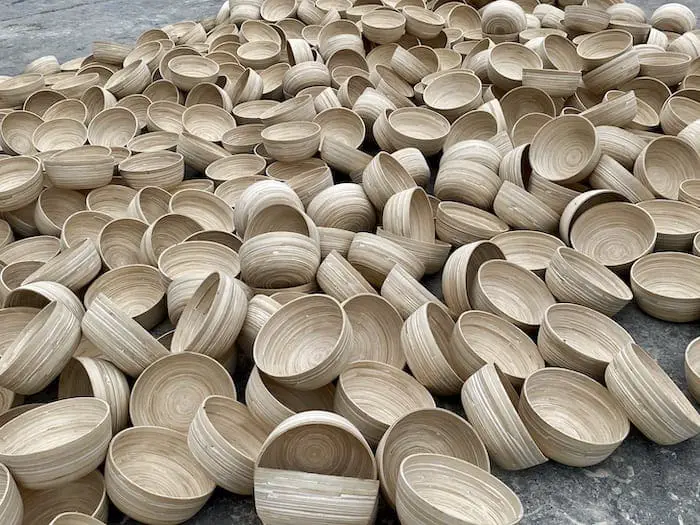
Spinning the Spun Bamboo
After the bamboo has been soaked and dried, the families spinning the spun bamboo will then cut the bamboo into smaller pieces. The size they will cut the bamboo pieces into will depend on what they need the bamboo for and their shape.
The households usually have a straightforward machine that helps them turn the bamboo into a round shape. These round shapes are then bent and then glued together. Usually, they are done in a flat form, and once the flat form is completed, it will then be bent or pulled over a ceramic or wooden form for the shape and size required.
Once the spun bamboo is placed on the mold and the shape has been formed, the pieces are dipped in a glue mixture again and dried. They are usually placed in a drying room to fully dry to ensure the moisture level is about 6 to 8%.
This entire spinning process, gluing, and drying usually happen in the spun bamboo handicraft village households.
How the Spun Bamboo Bases are Finished.
Once the spun bamboo products’ base is completed, the raw bases are usually brought into a larger factory to be finished. One of the reasons for this is that it allows for the paint, quality, and packing to be controlled in a larger facility.
The process of producing spun bamboo requires a lot of handwork and hand sanding. Most of the processes must be done by hand. Like a lot of Vietnamese production, spun bamboo is sanded repeatedly to ensure it has a very smooth surface.
Some of the basic steps used to finish spun bamboo products:
- Bases are brought in from the handicraft villages – The raw spun bamboo bases are brought in from the handicraft villages. The bases are then sanded to make sure they are as smooth as they need to be.
- Clay is placed on the bases – Clay is placed on the spun bamboo base where the lacquer will be painted. The clay is left out to dry in the sun and then sanded in between coats.
- Lacquer is painted on the bases – Once the base has been properly prepared, the lacquer can be painted on the prepared surface. Depending on the finish, the lacquer paint will have several coats of lacquer applied. The lacquer can be painted in a variety of colors. It can also be done in a shiny or matt finish.
- The pieces can also be stained – If you want to have the spun bamboo show some of the natural spun bamboo patterns, the pieces can also have a stained color.
- Spun bamboo can also be left natural – The spun bamboo can also be left in the natural color and natural look of the bamboo.
- Spun bamboo can be used as a base for other lacquer finishes – Spun bamboo can only be used as a base for other lacquer paint and even mother of pearls finishes. We use spun bamboo for some huge lacquer bowls that we do as it gives us the bowl’s shape at an economical price. The entire bowl will be lacquered, so there no parts of the spun bamboo showing.
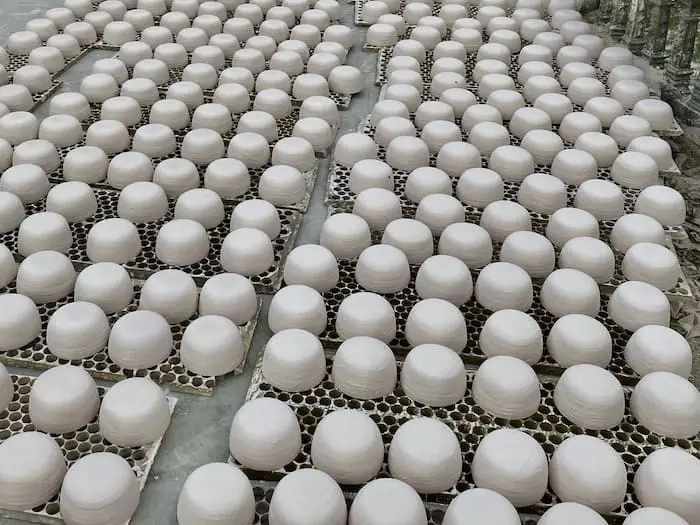
Using Spun Bamboo in Home Decor Production
Many ways spun bamboo can be used in home decor production. Here are some of the ways it can be used:
- Bowls – One way that spun bamboo has been used for hundreds of years is as a bowl. It can be made into tiny and also large sizes. It can show some of the spun bamboo finish, or we can lacquer the entire bowl and only use the spun base for the shape and base.
- Trays – Spun bamboo can be used in a variety of trays. They can produce the trays in oval, round, and even square or rectangular shapes.
- Vases – Spun bamboo can be made into a vase. One of the great things about using spun bamboo for a vase is that the vases can be produced to be quite large.
- Boxes – Spun bamboo can be made in a variety of shaped boxes. Even a heart-shaped box can be made with spun bamboo.
- Lamp bases and lighting – Spun bamboo can be made into a variety of shapes and finishes for lamp bases and lighting.
- Mirrors and wall art – Spun bamboo can be made into a mirror and wall art. It can show the naturally spun bamboo or be covered and have lacquer applied to it.
- Stools and other parts of the furniture – As spun bamboo is naturally strong, it can also be used for small stools and other furniture or furniture production parts.
- Almost any shape and style – Spun bamboo is extremely versatile in that it can be made into a variety of shapes and sizes. It is used to make tiny items like spoons, forks, and small bowls and be used for much larger items.
Spun Bamboo – A Renewable and Eco Product
Bamboo is considered a renewable and eco product. Bamboo is found naturally in Vietnam and is also grown in the highlands and delta areas of Vietnam. The bamboo is a fast-growing plant, so it can be harvested every 3 to 5 years.
Bamboo is considered a renewable and eco-product because when the bamboo is cut and harvested, the stem of the cut bamboo is left in the ground so that a new bamboo plant will then immediately start to grow. The entire process of growing the bamboo will then immediately start all over again. The bamboo will start to grow again without much care and attention.
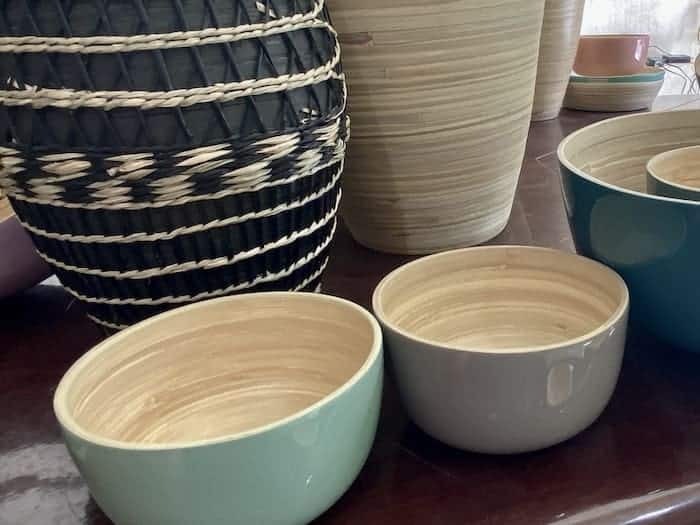
Spun bamboo not only has a fascinating look, but it is a great natural, eco-friendly product. It has the natural beauty of bamboo and is extremely versatile, as it can be made into various shapes, finishes, and forms.
Fnd out more about how Mondoro can help you create, develop, and manufacture excellent home decor and furniture products – don’t hesitate to contact me, Anita. Check out my email by clicking here or become a part of our community and join our newsletter by clicking here.
Mondoro gives out a FREE Lookbook to anyone interested. You can receive a copy of our latest Lookbook by clicking here.
Listen to our Podcast called Global Trade Gal. You can find it on all major podcast platforms. Try out listening to one of our podcasts by clicking here.
Subscribe to our Mondoro Company Limited YouTube Channel with great videos and information by clicking here.
Frequently Asked Questions
What is spun bamboo?
Spun bamboo is a traditional Vietnamese craft where bamboo is spun into fine threads and then molded into various shapes. It’s known for its lightweight, durability, and eco-friendly properties.
How is spun bamboo made?
The process involves splitting bamboo into thin strips, which are then spun and woven into desired shapes. These shapes are treated and sometimes combined with other materials like lacquer for added strength and aesthetics.
What products are commonly made from spun bamboo?
Spun bamboo is used to make a wide range of products, including bowls, vases, trays, lampshades, and even furniture. These items are admired for their natural beauty and craftsmanship.
Is spun bamboo environmentally friendly?
Yes, bamboo is a highly renewable resource, and its cultivation and processing have a lower environmental impact compared to other materials. Spun bamboo products are considered eco-friendly.
How do I care for spun bamboo products?
To care for these products, avoid prolonged exposure to water and do not use in a microwave or dishwasher. Clean with a damp cloth and dry immediately.
Are spun bamboo products durable?
Yes, when properly cared for, spun bamboo products are quite durable. However, they can be susceptible to cracks or warping if exposed to harsh conditions That is why you also want to work with a quality conscience supplier like Mondoro. Check out our email by clicking here.
How does spun bamboo differ from other bamboo products?
Spun bamboo is unique due to its spun and woven manufacturing process, which gives it a distinctive appearance and texture, different from carved or solid bamboo products.
Can spun bamboo products be recycled?
Since they are made from natural bamboo, these products are biodegradable. However, if treated with chemicals or lacquers, recycling options may be limited.
Related Questions
Is Bamboo Considered Good Luck For the Home?
Bamboo plants and bamboo products are considered to bring good luck and are auspicious for the home. It is said to attract good luck and wealth to the home.
To find out more you can read our blog Bamboo – An Auspicious Plant For Your Home by clicking here.
Acrylic Lacquer Paints: Finish For Various Products
Their application spans a broad spectrum, from the sleek bodies of classic cars to the vibrant curves of guitars and onto the cherished surfaces of antique furniture. Acrylic lacquer’s popularity is no coincidence—it’s a testament to its superior qualities and the finish it delivers. Read on as we explore the essence of acrylic lacquer, examining its distinct characteristics and the reasons behind its widespread adoption across diverse finishing practices.
You can discover more by reading Acrylic Lacquer Paints: Finish For Various Products by clicking here.
Latex Paint Vs. Acrylic Paint: 20 Key Differences
Two types stand out as the most recognized when exploring the world of paints: latex and acrylic paint. While these paints might appear similar at first glance, they possess distinct differences. Join us as we delve into the definitions of each paint and highlight their unique characteristics.
By clicking here, you can learn more by reading Latex Paint Vs. Acrylic Paint: 20 Key Differences.

